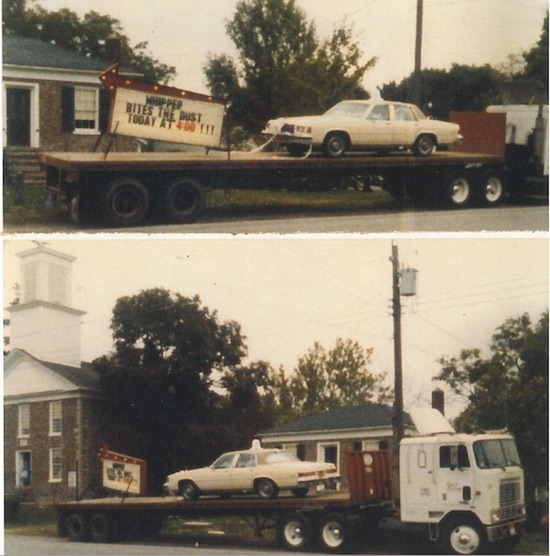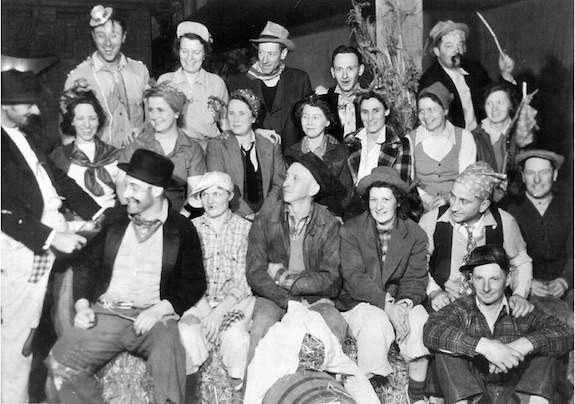Historic Childs: Pranks, and other diversions
‘Every outhouse in Gaines had been tipped over at one point or another.’
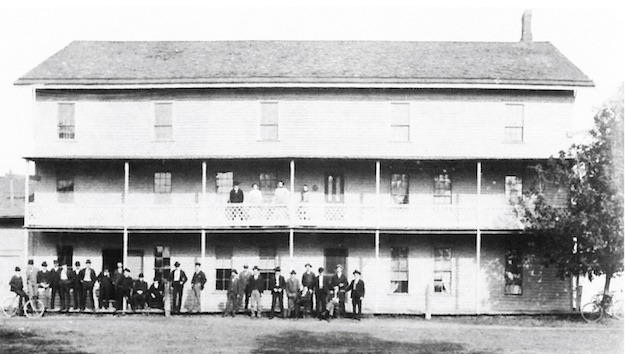
Jim Thurber’s store building, c. 1915, Gaines, attracted many pranksters, especially at the chicken coop.
By Doug Farley, Cobblestone Museum Director – Vol. 2 No. 32
When skimming through the pages of published history material, one can occasionally come across some shenanigans that might best be described as a prank, but I’m sure to the subject of the prank, it probably seemed more like a real nuisance.
Case in point, in 1979, (William) Clure Appleton (1902-1982) reflected on his days growing up in Gaines at the corner of Routes 104 and 279. Clure said, “When I was a kid, the boys and girls weren’t much different than they are today, except they didn’t take drugs and they didn’t drink to excess. However, they were full of mischief and I remember distinctly some of the things that happened on Halloween.”
It seems the cooper shop (barrel maker) was a frequent Halloween target. The boys took great sport in taking apart a barrel rack that was located outside of the cooperage, and removed it to be reassembled on the shop roof. Clure offered, “It was also a common occurrence for the boys to place a buggy or sleigh on top of the schoolhouse roof.”
Outhouses, as essential as they were to everyday life, were another frequent target of pranksters. Clure remarked that he thought “every outhouse in Gaines had been tipped over at one point or another.” It didn’t seem to matter if someone was in the shanty at the time, or not.
Any gathering of a half-dozen or more boys usually became fodder for a prank. Clure remembered that raids on local henhouses were a frequent occurrence, too. Jim Thurber’s chicken coop was a perennial favorite amongst the jokesters. Jim ran the store in the Grange building and kept his prize chickens outside under watchful eye. He had won many awards at the Orleans County Fair for his hens and roosters.
On one night in question, Clure and the Schuler boys were enjoying a card game and realized they had become powerfully hungry. The Schuler boys went over to Jim’s chicken house, one boy going inside and one staying outside as “lookout.” The chickens, of course, started to make a ruckus which aroused the ever alert Jim Thurber from his domestic tranquility. The lookout boy saw Jim coming with a lantern and knocked on the chicken house door to alert the chicken burglar, who quickly crawled down underneath the brooder.
Jim entered the coop, held his lantern up to count his chickens, and seeing all his chickens in place, decided it must have been a rat that aroused his fowl, and went back into the house. Once the coast was clear, the Shuler boy reached up and grabbed the prize rooster and proceeded to wring his neck. The nefarious plan then led the boys to a nearby dryhouse where apples and other fruit were dehydrated over a smoldering fire. The boys then cooked their prized chicken for the enjoyment of the card party. Of course, the next morning, when Jim Thurber discovered the loss of his prize chicken, he offered a few choice words in return, but unfortunately, had no rooster to show at that year’s fair.
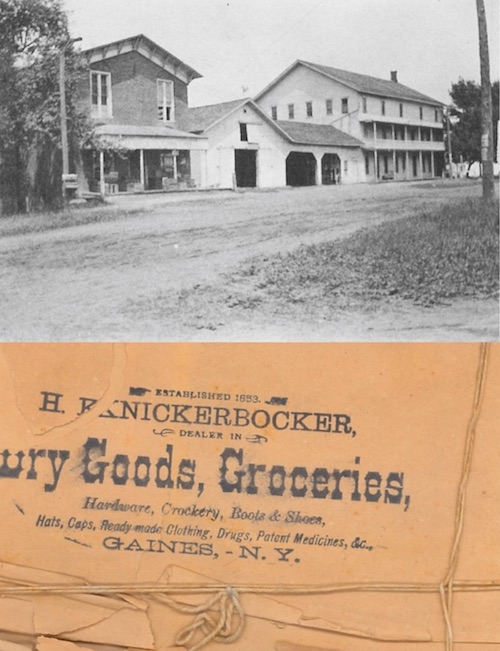
Knickerbocker Dry Goods, Gaines, at left above.
Jim Thurber wasn’t the only merchant that fell victim to frequent pranks. Another local shopkeeper, Harm Knickerbocker ran a store on the northeast corner in Gaines, next to the Grange Hall. The store was a brick building and the Knickerbockers lived up over the store. Harm didn’t run much of a store, though.
Reports are common that a typical day’s trade in the store was a meager ten or fifteen cents. Most of his stock in trade was several years old at best. Well the local boys had a bad habit of taking advantage of Mr. Knickerbocker’s good nature and would enter the store and request a penny’s worth of product from the far end of the building. During his travels, the kids would “help him” get rid of some his stale candy or tobacco by “helping” themselves.
Clure Appleton noted that later in life, he came to his senses and had regrets for his actions, but hindsight is always 20/20. As far as smoking the aforementioned tobacco was concerned, Clure’s father told him that if he was ever going to smoke, it was not going to be behind the barn, and if he did, his father would tan his hide. Any smoking Clure did had to be out in the open, under his father’s watchful eye, which he later reported, started him on a smoking habit that lasted 65 years.
And for intoxicating beverages, Clure said he learned another valuable lesson at an early age. He asked his Sunday school teacher if it was a “sin to drink too much.” She agreed that it was. But, also offered, “Clure, it’s a sin to eat too much, work too much, or play too much.” But her last admonition struck a note with Clure said he remembered it his whole life. “Everything that is carried to excess is a sin.”
Back in the 19th and late 20th century, every small community had a general store, and the Hamlet of Childs was no exception. The local store of course met the mercantile needs of the local citizens, but also, it served as a center of community engagement and social center. Many a story or yarn had been sewed while sitting around the wood stove in the old country store, and Gaines was no exception.
Locals can tell you about a certain local by the name of Hodie Howes whom the others liked to pick on when he came into the store. Hodie was quoted as saying, “I’m just as smart as any of you, if I could only think of it.” One fall evening Hodie came into the store and sat down in a chair near the stove. The usual bantering began. After a while, Hodie took a huge firecracker out of his pocket. One of the men said, “Where’d you get that firecracker?” Hodie said, “Oh, I found it in a drawer the other day. I think it’s left over from 1876. It probably won’t even work.”
With that disclaimer he got up and went to the stove and opened the door. Another man warned, “Hodie, I wouldn’t throw that in there if I were you.” Hodie said with bravado, “I don’t think it will blow up,” and with that threw it into the stove. Everyone in the store let out a collective gasp and ran towards the door. Hodie went back to his chair and let out a big belly laugh. You see, Hodie had sawn a broomstick down to size and made it look like a firecracker with a string for a fuse. Hodie enjoyed his prank and remarked, “He who laughs last, laughs best.”
The Cobblestone Church was a more recent setting for a prank, harkening back to October 1985. Those who were pranked were a newlywed couple, Jim and Cheryl Watson. The bridal couple had scheduled their wedding in the Museum’s Cobblestone Church. On the morning of the happy event, a flatbed truck rolled up in front of the church with a new Buick LaSabre loaded on it. There was also a lighted sign on the truck that stated, “Whipper bites the dust today at 4:00.”
Shortly before the wedding, Jim, known as Whipper by his companions, bought his fiancé, Cheryl, the Buick and surprised her by exchanging it with her old clunker in her parking spot at work. Of course, she really loved her new car. On the night of the wedding rehearsal, Jim’s buddies absconded with the car, much to Cheryl’s dismay. Jim assured her it was just a prank and it would be okay. The next morning, Jim and his brother were driving west on Ridge Road when Jim spotted an Orleans Trucking flatbed coming his way with a car on it. He hollered, “Hey, that’s Cheryl’s car!” His brother offered words of comfort, “It’s okay, Roger loaded it.” That made Jim even more nervous because Roger had a reputation for being accident prone.
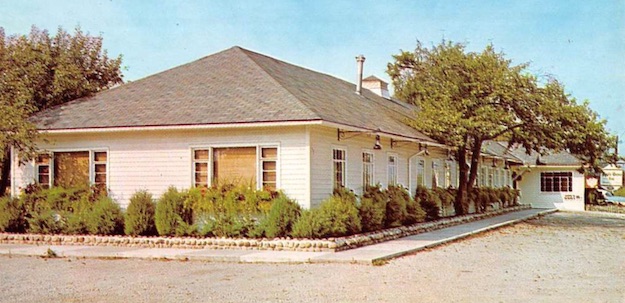
The former Apple Grove Inn, Medina, c. 1970
At any rate Jim and Cheryl got their car back from the pranksters in time for their honeymoon. However, as they left the reception which was held at the Apple Grove in Medina in haste, they neglected to make a thorough check of the car. It wasn’t until later that they discovered they had no luggage at all thanks to Jim’s buddies and their pranks.
Well, as we’ve all been told, “Turn-about is fair play.” I think we all get to chuckle when a prank goes awry and ends up a prank on the pranksters. Such was the case in a story told by Gary Ehrenrich to LeRoy Neeper. The Town of Ridgeway was a great place for young boys to grow up. The area around Oak Orchard was home to a number of obedient, respectful, but adventurous preteen boys. Halloween presented the perfect time to be a bit mischievous.
Clayton Fletcher, around 12 years old, Don Pritchard, Charlie Rorick and Ralph Axtel were great pals. They agreed that their prank would not be pulled on their own families, and settled on their neighbor, Mr. Gazes. The plan involved tipping over the Gazes’ outhouse, after all, neighbor kids had pulled this prank a few years before without much repercussion. The boys planned each movement and swore an oath of secrecy. Mr. Gazes got wind of the plan and decided to out-prank the pranksters.
Before nightfall on Halloween, Mr. Gazes moved his outhouse ahead about four feet, leaving a gaping cesspool exposed. Halloween was a dark night. The boys were full of excitement. They ran quickly in the dark, and in their haste fell full bore into the pit. The lads were a stinking mess and they knew the worst part would be that they were sure to be caught trying to sneak back into their homes later that night. The boys all agreed that the punishment they received from their parents was certainly worse than anything Mr. Gazes could have doled out.
Even most adults enjoy getting into the act for Halloween as seen here in this photo from 1943. This particular party was hosted by Jack and Gerry Larwood and Al and Ruth Mason, and involved a hobo theme. It was held at the Larwood Farm Implement Agency at Five Corners. Infamous Santa School creator, Charles Howard, even played a part in this elaborate Halloween party. Howard was secured to decorate the room for the “hobo” theme.
The amazing planning and execution for this party even involved laying down railroad track along West Bacon Road to add to the mystique. A railroad handcar was used on the track to transport guests into the party. The party ran for two nights with much merriment enjoyed. Bill Lattin tells the story of one prank that came out of this party, too. His father, Cary Lattin, had a devilish wit, and pulling a prank on another unsuspecting “hobo” was just too much fun to pass up. Cary’s costume for the evening involved a “putty” nose, which at the right moment, he slipped off and inserted into Agnes Wilson’s drink. When her libation neared the bottom of the glass she reacted with horror at her discovery. Bill reported that Agnes was still talking about the prank 40 years later.
Those enjoying this 1943 party include: (Front row L-R) Standing – Cary Lattin, Seated – John Larwood, Avis Latin, Robert Brown, Katherine Church, Fred Miller, Bill Phillips and (Seated on Floor) Ward Wilson. (Second row) Jean Jackson, Geraldine Larwood, Doris Phillips, Dorothy Miller, Agnes Wilson, Angie Brown, and Grace Phillips. (Third row) Albert Mason, Ruth Mason, Marcus Phillips, Dr. John Jackson and Sanford B. Church, Esq,
Our last Halloween prank involves the Fletcher clan that lived in a big house on Ridge Road in the Town of Ridgeway, about a half mile east of Oak Orchard River. Beatrice and Harry Fletcher had four children: Clayton, Shirley (Mrs. Brent Manker), Florence (Mrs. Garry Ehrenrich) and Mary (Mrs. Don Hall). Halloween was an exciting time for the kids. The boys liked to play pranks, the girls liked to dress up, and they all liked the Halloween treats.
Mrs. Fletcher insisted that all of her children had to stay together. They could join with other neighborhood children, but had to stay together. The older kids did NOT want to take the younger kids, but that was the rule. They especially did not want to take their youngest sister, Mary, fearing she would tattle on them if they pulled a prank. Knowing that there was no other way, the older siblings took Mary along with them.
Later that night, the older kids decided it was time to pull a prank, so they decided to tie Mary to a mailbox while they went off and performed the dirty deed. Luckily, nothing nefarious happened to Mary during her captivity, but like Joseph of old who was thrown into a pit by his brothers, Mary remembered the ordeal and retold the tale for years whenever Halloween pranks became the topic of conversation.


















